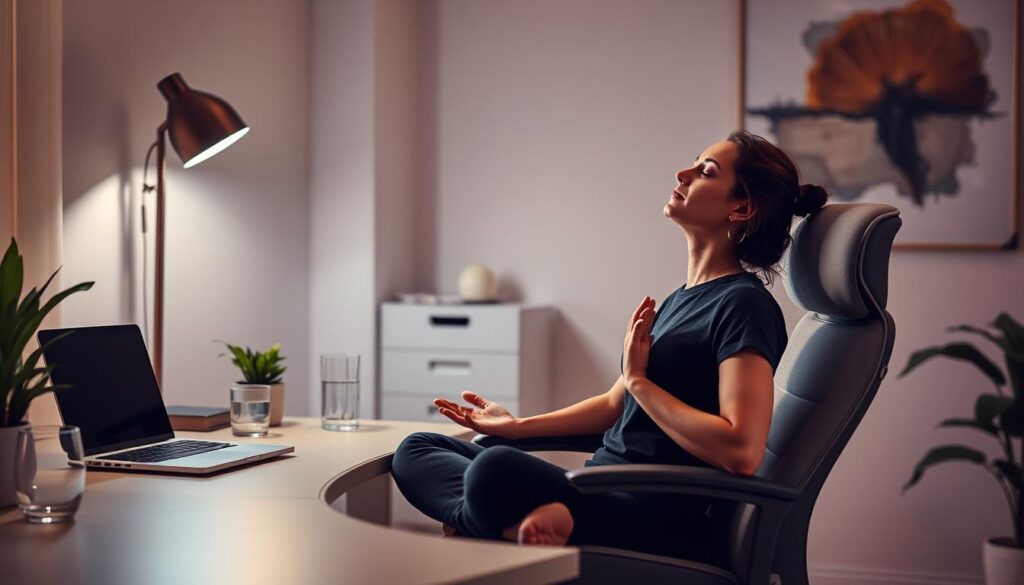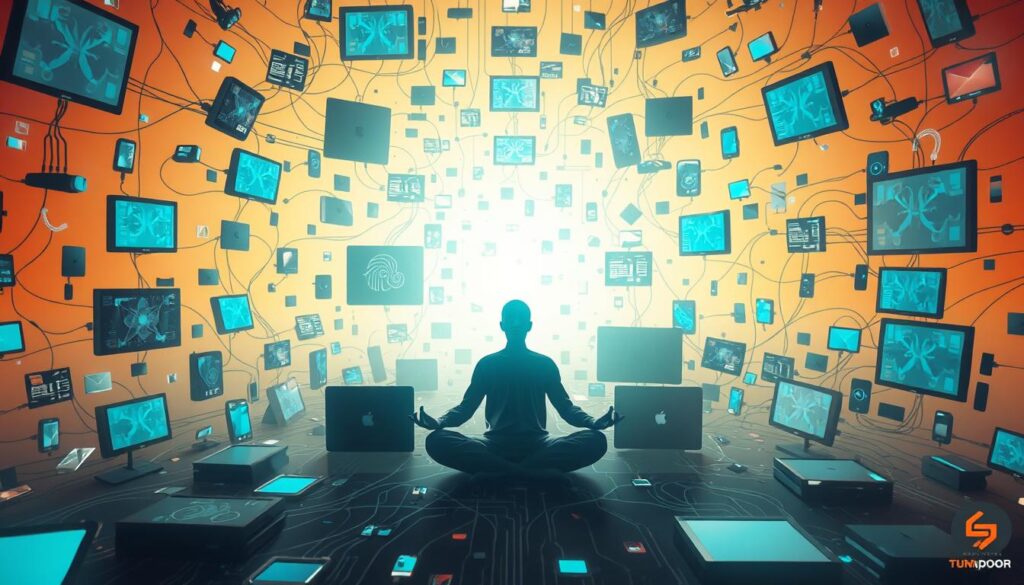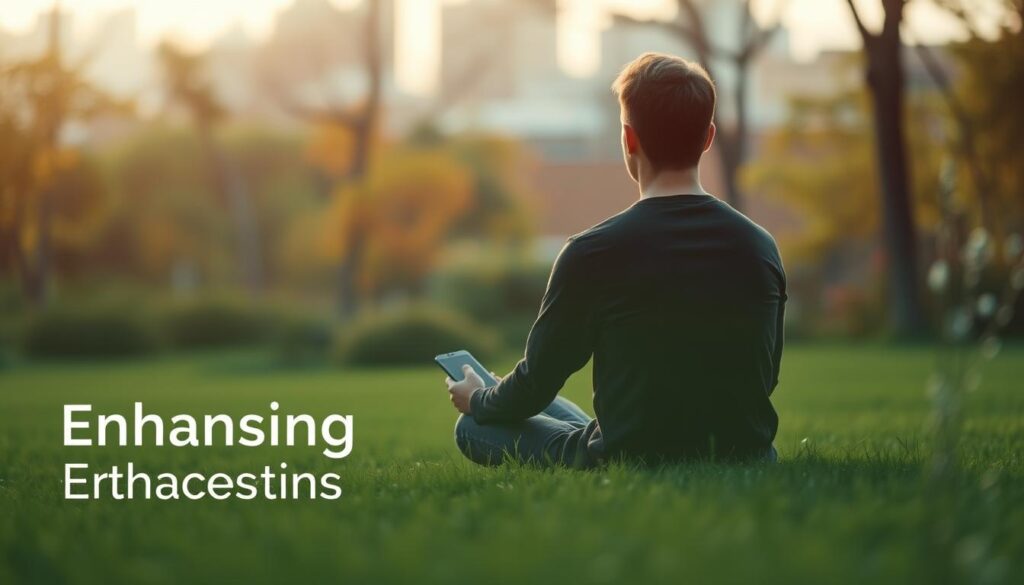Effective Strategies to Overcome Digital Fatigue and Boost Mental Health

Do you lose 581 hours of productivity each year to digital distractions? In today’s world, screen exhaustion is a silent killer of productivity. It takes away valuable time and mental energy from professionals.
Digital fatigue is more than just feeling tired from tech. It affects your thinking, feelings, and happiness. As we use digital devices more, it’s key to understand and manage screen exhaustion.
This guide will show you how to focus better, protect your mind, and have a healthier tech relationship. By spotting digital overload signs and using the right strategies, you can turn your digital life from draining to empowering.
Key Takeaways
- Digital fatigue can cause significant productivity loss
- Screen exhaustion impacts cognitive and emotional health
- Awareness is the first step in managing technology use
- Strategic interventions can restore mental energy
- Balanced technology consumption is achievable
Understanding Digital Overload in Modern Life
In today’s world, technology burnout is a big problem. The digital world is full of information, leading to virtual overload. This affects your mind and how you think.
Digital use has gone up a lot lately. Here are some interesting facts:
- The average American spends 7 hours and 4 minutes looking at screens daily
- 49% of people report suffering from digital fatigue
- 40% interact more through devices than in physical interactions
The Science Behind Screen Exhaustion
Looking at screens all day is hard on your brain. Studies show that too much screen time can mess with your brain. Multitasking isn’t as helpful as you might think – only 2.5% of people do it well.
Impact on Cognitive Function
Digital overload messes with how you think. Switching tasks can take up to 25% more time than focusing. Also, distractions make you stressed. It takes 23 minutes to get back to focus after a break.
The Role of Information Overload
In an era where information flows from hundreds of cloud applications, it’s easy for the mind to drown in digital chaos, draining our mental energy. The challenge today isn’t accessing information but managing it without feeling overwhelmed. Recognizing the impact of this digital flood on our lives is the first step to reclaiming focus, protecting our mental well-being, and navigating the digital world with mindfulness.
Knowing these facts helps you fight technology burnout in your daily life.
The Hidden Cost of Constant Connectivity
Your constant digital connection has a high cost. It’s not just about feeling tired. It’s a full breakdown of your mental performance and well-being.
Digital multitasking might seem smart, but it’s not. About 40% of adults do it, hurting their productivity and mental health. Cyber strain has many serious effects:
- Task-switching can waste up to 40% of your productive time
- Chronic multitaskers experience significant cognitive performance declines
- Increased likelihood of experiencing symptoms of depression and anxiety
The effects on your brain are deep. Studies show constant digital use reduces brain control and boosts stress. Your brain gets overwhelmed, struggling to focus.
The perceived benefits of constant connectivity mask significant drawbacks to mental performance and life satisfaction.
To escape this digital trap, you must understand its impact. Recognize how online fatigue harms your brain. Then, you can take steps to improve your mental clarity and productivity.
Digital Fatigue: Signs and Symptoms
Digital fatigue is a big problem in our world today. It affects our mental and physical health. Knowing the signs is key to staying well.
Physical Manifestations of Internet Weariness
Your body shows signs of digital exhaustion. Studies have found several important symptoms:
- Persistent eye strain and headaches
- Disrupted sleep patterns
- Chronic neck and shoulder tension
- Decreased physical activity
Psychological Effects of Technological Overload
Being online too much can really affect your mind. A study found that too much screen time can change your brain.
| Psychological Symptom | Potential Impact |
|---|---|
| Anxiety | Increased cortisol responses |
| Concentration Difficulties | Reduced cognitive performance |
| Mood Fluctuations | Emotional instability |
Social Impact and Relationships
Digital fatigue affects not just you, but also your relationships. Stanford University found that online chats use more brain power than talking face-to-face.
- Reduced empathy
- Increased feelings of isolation
- Diminished quality of personal interactions
Spotting these signs early can help you fight the bad effects of too much internet and technology.
Breaking the Cycle of Screen Addiction

Digital burnout is a growing problem in our world. Being always connected to screens can make you feel drained. To break free, you need to use specific strategies and focus on your digital health.
It’s important to understand why you might be addicted to screens. They can make you feel good, like drugs do, leading to a cycle of constant checking. This can change how your brain works, making it hard to stop.
“Technology is a useful servant but a dangerous master.” – Christian Lous Lange
Here are some ways to fight screen addiction:
- Make sure some areas of your home are screen-free
- Limit how much time you spend on devices each day
- Use apps that block certain websites to stop mindless browsing
- Have a digital detox in the evening
- Try mindfulness meditation
Taking regular breaks from screens can help a lot. Here’s a simple plan:
| Duration | Activity | Benefit |
|---|---|---|
| 20 minutes | Screen-free break | Reduces eye strain |
| 1 hour | Outdoor physical activity | Improves mental clarity |
| Evening | No digital devices | Enhances sleep quality |
Remember, overcoming screen addiction takes time. Be kind to yourself and celebrate every small win in your journey to better digital health.
Mindful Technology Usage Strategies
Digital fatigue is a big problem in our world today. It’s important to know how to handle screen exhaustion to stay mentally healthy and productive. How you use technology affects your health and how well you think.
Setting digital boundaries is key to fighting the constant stress of being connected all the time. Studies show that 85% of people think setting clear tech limits can make them feel better mentally.
Creating Digital Boundaries
Creating good digital boundaries takes planning. Here are some useful tips:
- Set times for work and personal device use
- Make areas in your home where devices are not allowed
- Turn off alerts you don’t need
- Use airplane mode when you need to focus
Time-Blocking Techniques
The Pomodoro Technique is a great way to fight digital fatigue. It works like this:
- Work in 25-minute blocks
- Take 5-minute breaks
- Take longer breaks of 15-30 minutes after four cycles
Implementing Digital Detox Periods
Digital detoxes can really help with screen exhaustion. Try to have regular times when you’re not using devices. Research shows that 24-hour digital detoxes make 78% of people feel better and less anxious.
“Mindful technology use is not about complete abstinence, but balanced engagement.” – Digital Wellness Expert
By being mindful of how you use digital tools, you can keep your mind healthy and find balance in our connected world.
Enhancing Focus in a Distracted World

In today’s world, staying focused is key. The constant stream of notifications and emails can make it hard to concentrate. This can lead to feeling overwhelmed and mentally tired.
There are ways to fight this and stay sharp. Here are some effective methods:
- Implement the Pomodoro Technique: Work in focused 25-minute intervals with 5-minute breaks
- Create distraction-free work zones by silencing notifications
- Practice daily mindfulness meditation for 10 minutes
- Identify and prioritize your Most Important Tasks (MITs)
Studies show that focusing better can really help:
| Productivity Strategy | Impact |
|---|---|
| Focus Sprints | 43% productivity increase |
| Daily Meditation | Improved cognitive function |
| Inbox Management | Prevents 50% focus time loss |
Your mental bandwidth is a precious resource. By using these strategies, you can fight off burnout. You’ll also build lasting habits that boost your work and personal life.
Building Resilience Against Digital Burnout
Digital burnout is a big problem in our world today. It affects 22% of workers and 19% of people in general. It’s important to know how to stay strong in the digital world.
Developing Healthy Tech Habits
To fight online fatigue, we need to be smart about our tech use. How we use technology affects our mind and work.
- Make tech-free areas in your home
- Set limits on screen time
- Take breaks from devices regularly
Environmental Optimization
Your workspace is key in fighting cyber strain. Make it a place that helps you think clearly and feel less overwhelmed by technology.
| Strategy | Impact |
|---|---|
| Natural lighting | Reduces eye strain |
| Ergonomic workspace | Minimizes physical discomfort |
| Noise-canceling headphones | Enhances focus |
Stress Management Techniques
It’s important to handle stress well to avoid digital burnout. Add mindfulness practices and relaxation to your daily life.
- Do 5-10 minutes of meditation every day
- Use breathing exercises during breaks
- Do physical activities
- Get 7-9 hours of sleep
Remember, resilience is not about eliminating stress, but about developing effective coping mechanisms.
Tools and Apps for Managing Screen Time
Managing internet weariness is key in today’s digital world. Technology has given us smart apps and tracking tools to fight technological drain. These tools help you control your screen time and boost your digital health.
Let’s look at some powerful tools to manage digital use:
- RescueTime: Automatic time tracking across multiple platforms
- Forest: Productivity app with gamified focus techniques
- Opal: Screen time management with AI-powered insights
- Canopy: Cross-device digital wellness platform
When choosing screen time apps, look for these features:
- Detailed activity reports
- Customizable app blocking
- Goal-setting capabilities
- Productivity tracking
| App | Platform | Pricing | Key Feature |
|---|---|---|---|
| RescueTime | Multi-platform | Freemium | Detailed productivity reports |
| Forest | Mobile | $1.99-$3.99 | Gamified focus technique |
| Opal | Mobile | $8.29/month | AI-powered insights |
| Canopy | All devices | $9.99/month | Cross-device management |
Tip: Pick an app that fits your digital wellness goals and work style.
Windows and iOS users have built-in tools for screen time management. Windows 10 and 11 have Family Safety and Activity Tracker. These tools let you set app limits, track usage, and improve your tech use.
Creating a Sustainable Digital Wellness Plan
Fighting digital burnout needs a solid plan for handling tech. Your digital wellness plan is more than a quick solution. It’s a detailed guide to get your mental energy back and fight pixel exhaustion.
Begin by doing a deep dive into your digital habits. Keep track of how much time you spend on screens, find out what stresses you digitally, and see where tech hurts your well-being.
- Measure daily screen time across devices
- Identify productivity interruptions
- Note emotional responses to digital interactions
Studies show that too much digital use can change how our brains work. With the right strategies, you can change these patterns and find mental peace again.
- Set Clear Boundaries: Decide when to check emails and social media
- Practice Digital Detox: Take 24-hour tech breaks
- Use Tracking Tools: Watch your sleep, mood, and screen time
The 20-20-20 rule is easy to follow to avoid eye strain. Every 20 minutes, look at something 20 feet away for 20 seconds. Cutting down on digital use can boost sleep, focus, and happiness by up to 35%.
Creating a lasting digital wellness plan is a personal journey. Be kind to yourself and make small, important changes that help your mental and physical health.
Conclusion
Screen exhaustion is a big problem in our world today. It’s not about cutting out technology completely. It’s about finding a good balance with it. By using the tips we’ve shared, you can change how you use screens and keep your mind healthy.
Studies show that cutting down on screen time can really help. 75% of people feel better mentally when they use screens less. And 65% say they’re more mindful when they use technology on purpose. Your journey to better digital health starts with small steps. Set limits, take breaks, and focus on your mental health.
Managing digital fatigue is a personal challenge. Using the Pomodoro Technique, taking breaks, and being mindful with tech can boost your focus and emotional strength. By tackling screen exhaustion, you’ll work better, feel less stressed, and live a more balanced life.
It’s time to make a change. Begin with one strategy, keep track of your progress, and build healthier digital habits slowly. Your mind needs care in today’s fast world.
FAQ
What exactly is digital fatigue?
Digital fatigue is feeling tired from using digital devices too much. It includes feeling tired from screens, too much information, and being always connected. This can make you less productive, stressed, and affect your mental health.
How does digital fatigue affect my brain?
Too much screen time hurts your brain. It messes with your focus, memory, and making decisions. Your brain gets overwhelmed, leading to feeling tired and not thinking as well.
What are the primary symptoms of digital fatigue?
Signs of digital fatigue include physical issues like eye strain and headaches. It also affects your mood, making you anxious, moody, and hard to focus. You might feel isolated and less empathetic too.
Can digital fatigue impact my professional performance?
Yes, it can hurt your work. Being always online makes it hard to focus and make good decisions. You might feel stressed, less creative, and take longer to respond.
How can I effectively reduce my screen time?
To cut down on screen time, try setting areas where devices are not allowed. Use apps to block distracting sites and take breaks from technology. Set times for using devices and take breaks to recharge.
Are there specific tools to help manage digital fatigue?
Yes, there are tools like apps to track screen time and software to help you stay focused. There are also features on devices to manage your use. AI can help you stay on track by monitoring your tech use.
How long does it take to recover from digital burnout?
It depends on the person, but you can start to feel better in 2-4 weeks. It might take months to fully recover by reducing your tech use and finding healthier ways to interact with technology.
Is digital fatigue a recognized medical condition?
It’s not officially a medical term, but experts are starting to see it as a serious issue. It’s seen as a condition caused by too much technology, affecting both your mind and body.
Can digital fatigue affect my personal relationships?
Yes, it can. Being too tired from technology can make you less available and less empathetic. This can hurt your relationships with family and friends, making them less fulfilling.
What are the long-term risks of untreated digital fatigue?
If you don’t deal with digital fatigue, it can lead to chronic stress and mental health problems. It can also harm your sleep, thinking skills, and overall happiness. It might make it hard to work well and enjoy life.
